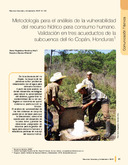Metodología para el análisis de la vulnerabilidad del recurso hídrico para consumo humano: validación en tres acueductos de la subcuenca del río Copán, Honduras
ISSN
e-ISSN: 1659-1216Date
04-2009Autor Corporativo
CATIE - Centro Agronómico Tropical de Investigación y Enseñanza
Type
Artículo
Metadata
Show full item recordAlternative title
A methodology for analyzing drinking water vulnerability: validation in three acqueducts of the Copán River subwatershed, Honduras
Description
10 página, 4 figuras, 5 tablas
Abstract
Se elaboró una propuesta metodológica para el análisis de vulnerabilidad del recurso hídrico para consumo humano, a nivel de todo el sistema, desde la zona de recarga en nacientes o fuentes, hasta la gestión administrativa de los acueductos. La metodología integra aspectos cualitativos y cuantitativos, bajo un enfoque sistémico e interdependiente, y consta de 10 componentes y 63 indicadores. La validación se hizo en tres sistemas de acueductos de la subcuenca del río Copán en Honduras: El Malcote-Don Cristóbal, El Estribo y Pinalito-Salitre. El análisis de la vulnerabilidad global de los sistemas permitió determinar que Pinalito-Salitre tiene una vulnerabilidad alta y los sistemas El Estribo y El Malcote-Don Cristóbal tienen vulnerabilidad media. La evaluación de los tres sistemas permite tomar decisiones para la priorización de acciones y la asignación de recursos, tanto a nivel del municipio como de la mancomunidad de municipios que los agrupa. La metodología permitió identificar y cuantificar los componentes del sistema y los indicadores en cada componente que son más críticos y vulnerables. De manera complementaria, se identificaron las medidas de adaptación practicadas a nivel local por los usuarios del agua. La metodología es una herramienta flexible que puede adaptarse a condiciones particulares. This study proposed a methodology to analyze the vulnerability of water for human consumption throughout the system, from the recharge areas to administrative management of aqueducts. The methodology includes both qualitative and quantitative aspects with a focus on a systemic interdependent approach. It consists of 10 components and 63 indicators. The methodological validation was carried out in three aqueducts of the Copán River subwatershed, Honduras: El Malcote-Don Cristóbal, El Estribo and Pinalito-Salitre. The analysis showed that global vulnerability in Pinalito-Salitre is high and medium in El Estribo and El Malcote-Don Cristóbal. The evaluation of these three systems helped in decision making, priority setting and resources allocation, within both the municipality and the administrative organization that groups them all. The methodology also identified and quantified the most critical system components and indicators. Complementarily, preventive and reactive adaptation measures practiced by local users and water service providers were also identified. This methodology constitutes a flexible tool that can be adapted to specific conditions.
Keywords
Delegation
Sede Central
Publisher
CATIE, Turrialba (Costa Rica)
URI (Permanet link to cite or share this item)
https://repositorio.catie.ac.cr/handle/11554/6568Collections
- Publicaciones y documentos [4167]


